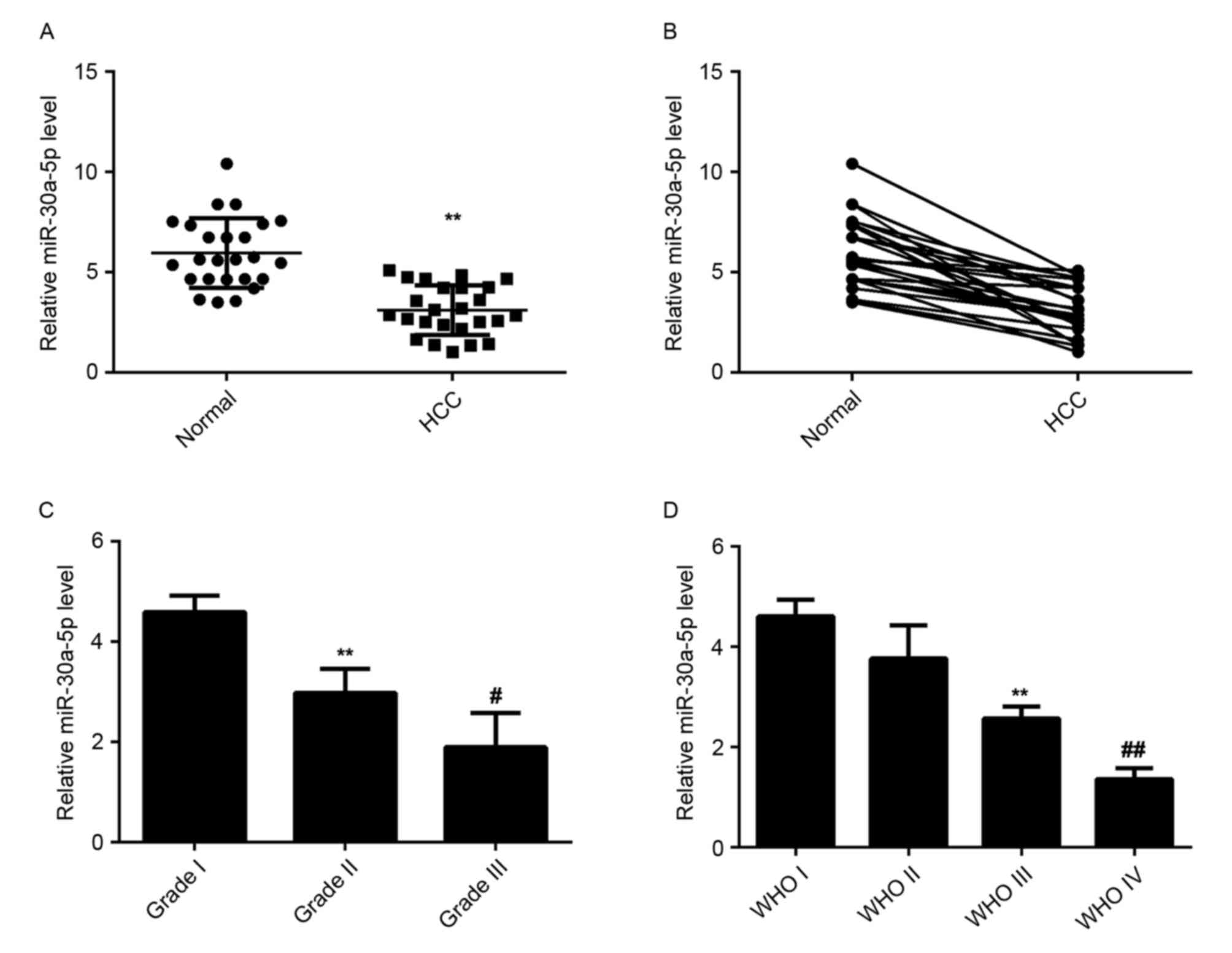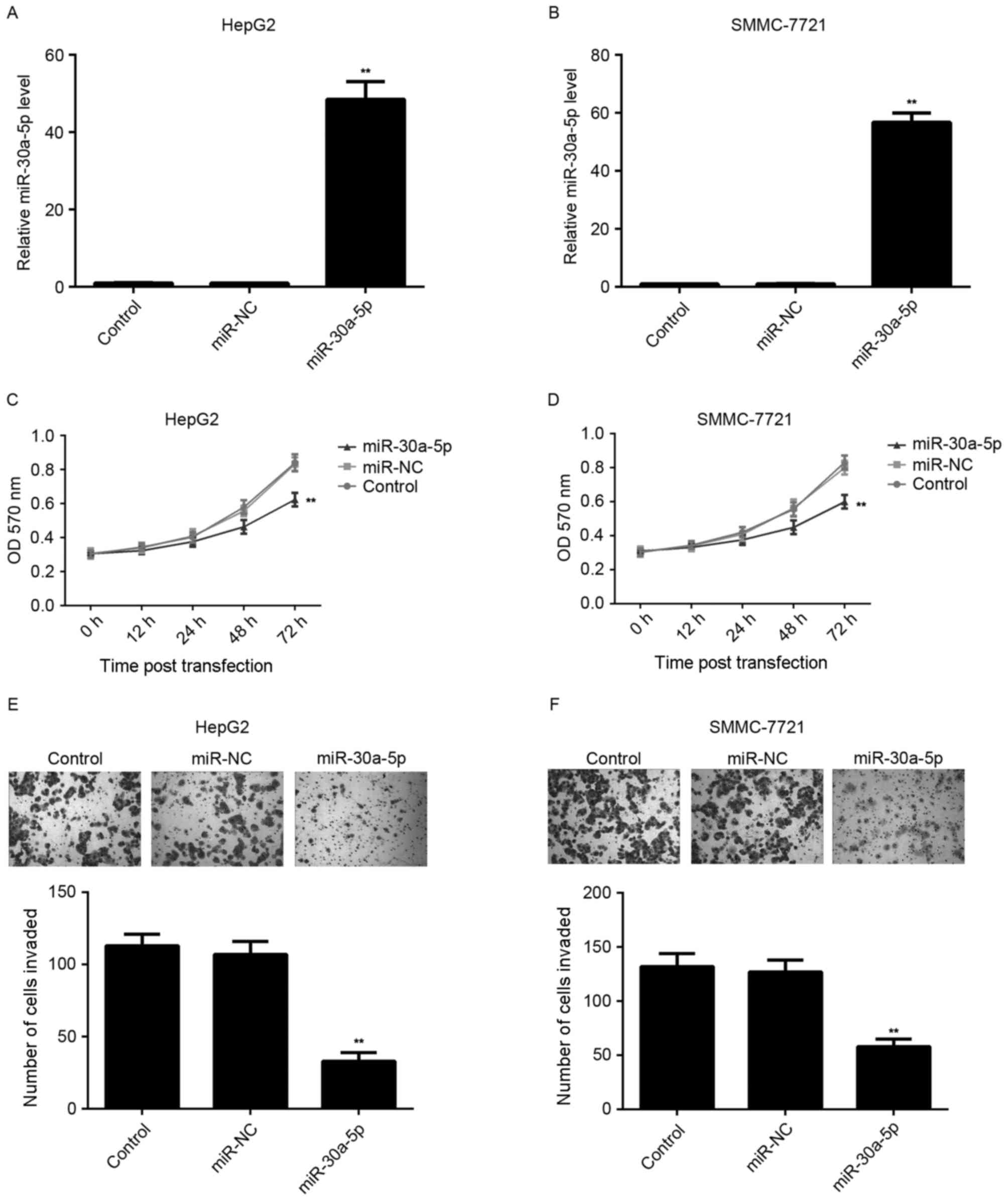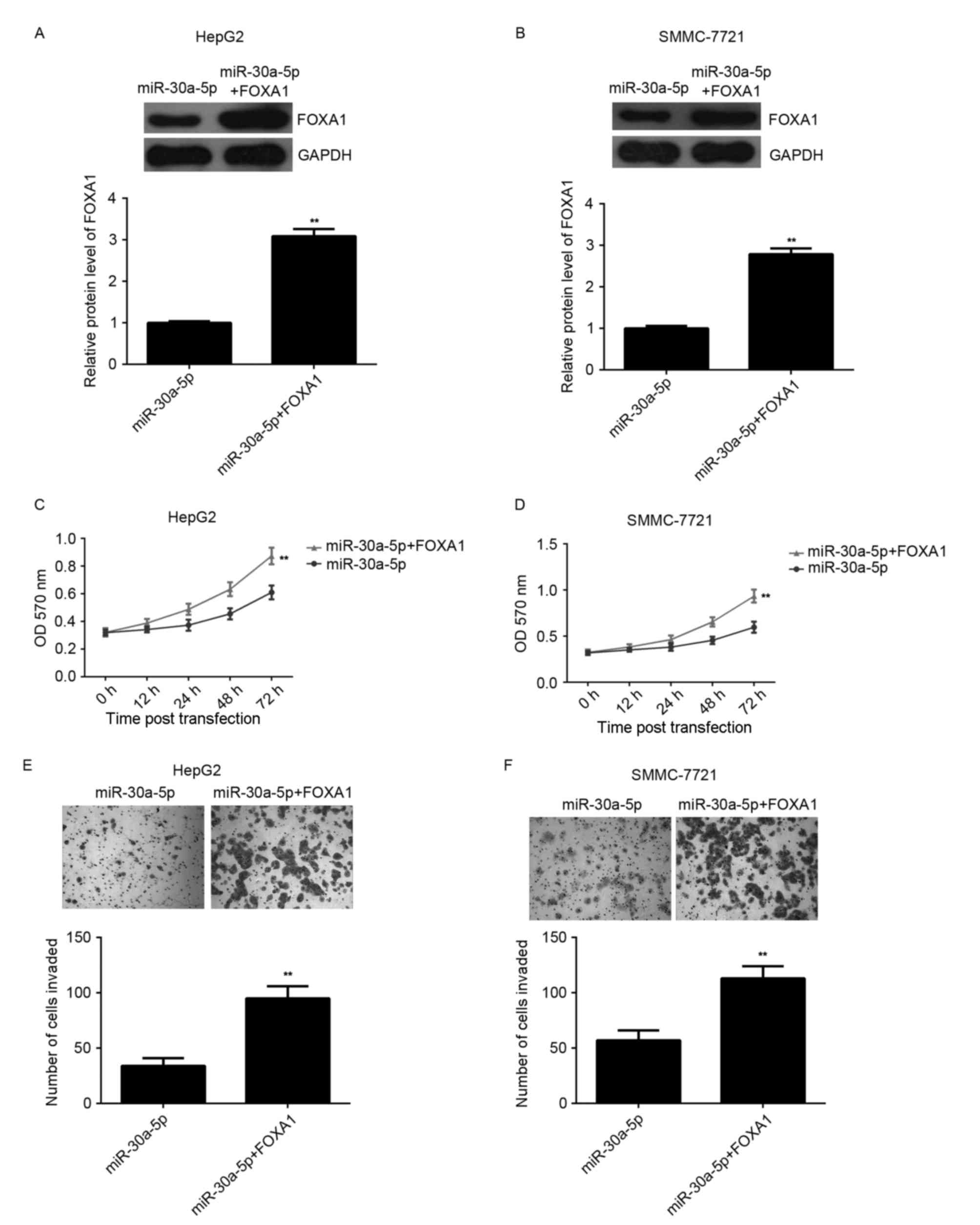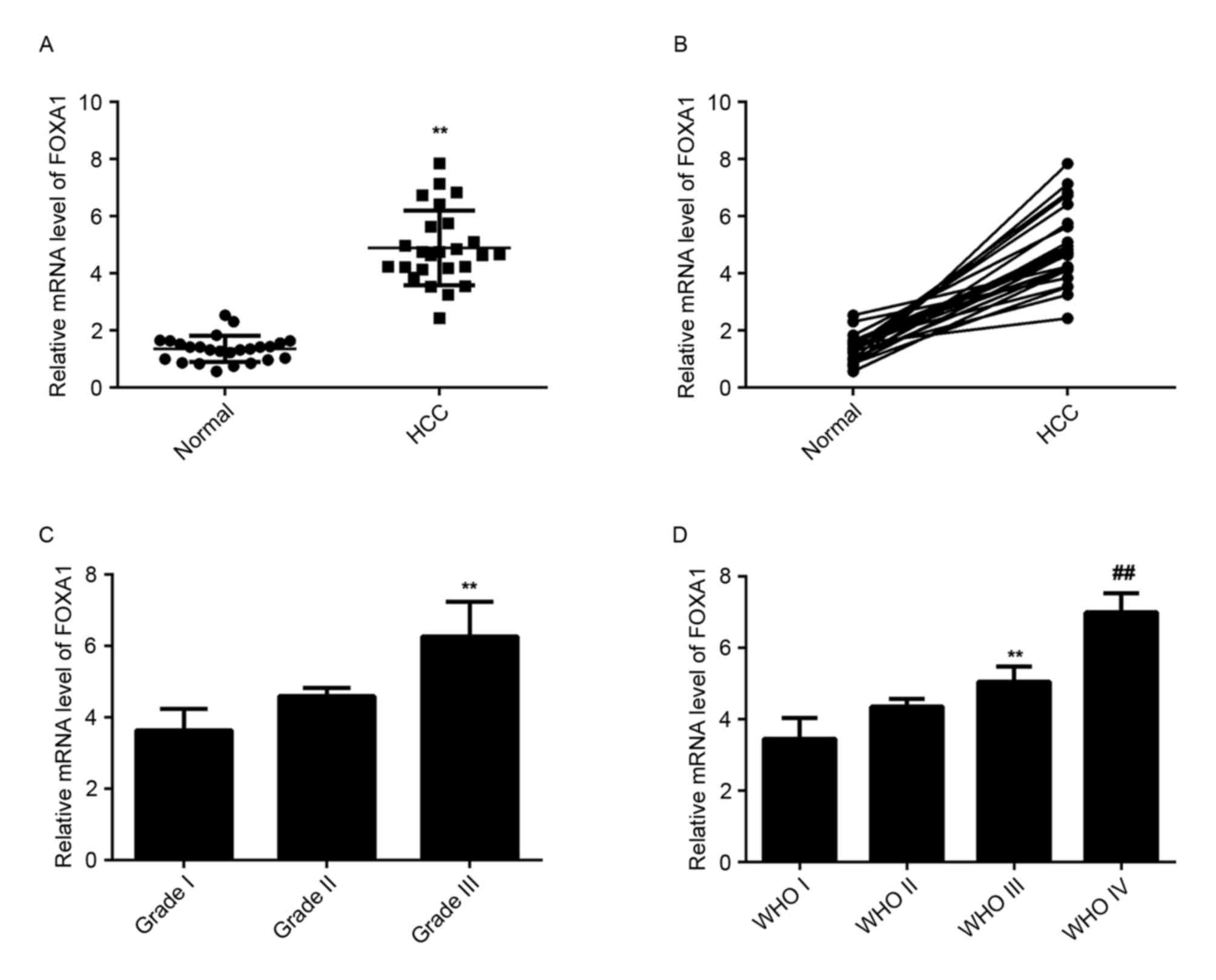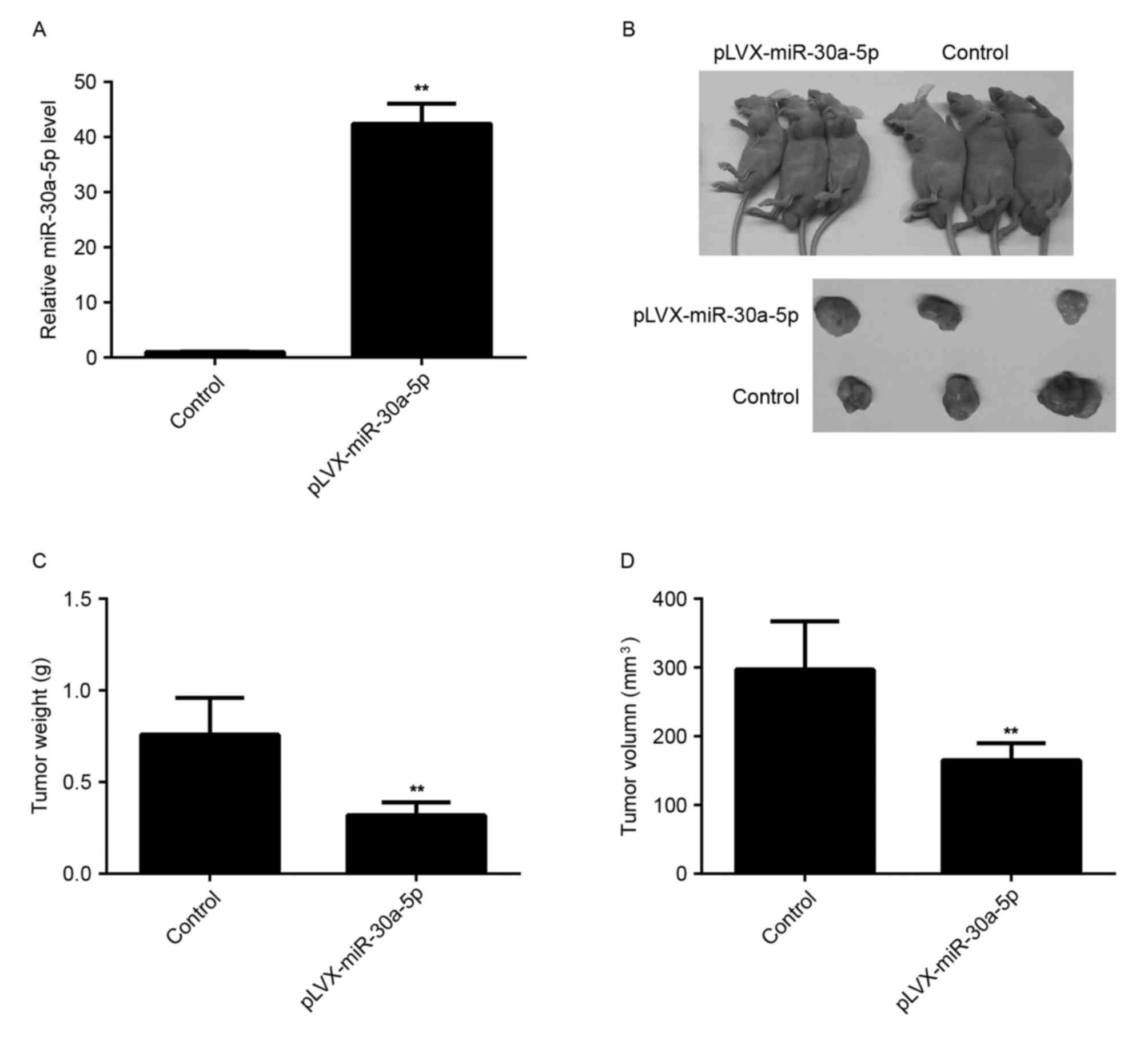MicroRNA-30a-5p suppresses proliferation, invasion and tumor growth of hepatocellular cancer cells via targeting FOXA1
Retraction in: /10.3892/ol.2021.12835
- Authors:
- Published online on: August 10, 2017 https://doi.org/10.3892/ol.2017.6745
- Pages: 5018-5026
Abstract
Introduction
Hepatocellular carcinoma (HCC), one of the most common types of cancer in human, causes ~1 million mortalities a year and therefore is one of the leading causes of cancer-associated mortalities worldwide (1). Understanding of the molecular mechanisms underlying HCC is important for the development of effective treatment strategies. Deregulation of oncogenes or tumor suppressors have been demonstrated to be involved in the development and progression of HCC (2).
MicroRNAs (miRs) are a group of small non-coding RNA containing ~22 nucleotides and have been demonstrated to suppress protein translation or induce mRNA degradation via binding to 3′untranslated region (3′UTR) of their target mRNAs (3). In the recent decade, the deregulation of specific miRs has been observed in various types of human cancer (4,5). These miRs participate in the development and malignant progression of human cancer by negatively regulating the expression of their target genes, which act as oncogenes or tumor suppressors (4). Previously, the deregulation of specific miRs has been identified in HCC, including miR-148a, miR-203, miR-138, miR-122 and miR-124 (6–9). Therefore, these miRs may become potential therapeutic targets or candidates for HCC treatment (4,10). Notably, miR-30a-5p has been implicated in many types of human malignancies. For instance, miR-30a-5p is overexpressed in glioma (11) but significantly downregulated in lung cancer (12). Accordingly, miR-30a-5p serves different roles in different types of cancer (11,12), and its functions require full elucidation in different cancer types including HCC.
Forkhead box A1 (FOXA1) is a member in the FoxA gene family and shows redundant expression in liver development and metabolism (13). The oncogenic role of FOXA1 in liver cancer has gradually been revealed in recent years. FOXA1 is essential for estrogen and androgen signaling by acting as central regulators of sexual dimorphism in liver cancer (14). Recently, Dou et al (15) reported that miR-212 was able to suppress HCC growth by inhibiting the expression of FOXA1. However, the regulatory mechanism of FOXA1 remains largely unclear. As one gene could be regulated by various miRs, other miRs targeting FOXA1 may also have important roles in HCC.
In the present study, the authors aimed to reveal the expression and role of miR-30a-5p in the mediation of proliferation and invasion in HCC. In addition, the study also investigated the association between miR-30a-5p and FOXA1 in HCC cells.
Materials and methods
Tissue samples
The present study was approved by the Ethics Committee of Linzi District People's Hospital (Zibo, China). Written informed consent was obtained from patients. HCC tissues and matched adjacent non-tumor tissues were obtained from 25 patients with HCC (diagnosis confirmed by pathological analysis) from April 2013 to September 2013 at Linzi District People's Hospital during surgical resection. The patients included 17 males and 8 females, from 39–66 years old, with mean of 53.5 years. The patients were staged according to WHO stage and grading system (16). Patients received no treatment prior to surgical resection. The tissues were store at −80°C until further use.
Cell culture
HCC HepG2 and SMMC-7721 cells were obtained from the Cell Bank of the Chinese Academy of Sciences (Shanghai, China). The cells were cultured in DMEM medium (Gibco; Thermo Fisher Scientific, Inc., Waltham, MA, USA) with 10% fetal bovine serum (FBS; Gibco; Thermo Fisher Scientific, Inc.) in a cell incubator containing 5% CO2 at 37°C.
Transfection
miR-30a-5p mimic and negative control miRs (miR-NC; both 100 nm) were provided by Sigma-Aldrich (Merck KGaA, Darmstadt, Germany). FOXA1 open reading frame (ORF) plasmid was generated from Amspring Biological Technology Co. Ltd. (Changsha, China). The cells were seeded in 24-well plates (1×105 cells/well), and transfection was performed using 100 nM diluted Lipofectamine 2000 (Invitrogen; Thermo Fisher Scientific, Inc.), according to the manufacturer's instructions. The cells were subsequently cultured in a cell incubator containing 5% CO2 at 37°C, and harvested at 48 h post-transfection for further analysis.
Quantitative reverse transcription polymerase (RT-qPCR)
Total RNA from tissues and cell lines was isolated using RNA TRIzol® (Invitrogen; Thermo Fisher Scientific, Inc.), according to the manufacturer's instructions. Reverse transcription was conducted using the QIAGEN OneStep RT-PCR Kit (Qiagen China Co., Ltd., Shanghai, China), according to the manufacturer's protocol. Expression of miR-30a-5p was determined using TaqMan MicroRNA Assay kit (Applied Biosystems; Thermo Fisher Scientific, Inc.) according to the manufacturer's instructions. U6 was used as a control for normalization. For detection of levels of FOXA1 mRNA, primers for FOXA1 and GAPDH were obtained from Applied Biosystems (Thermo Fisher Scientific, Inc.). GAPDH was used as a normalization control. The PCR reaction was performed on the 7500 Real-Time PCR system (Applied Biosystems; Thermo Fisher Scientific, Inc.). The primer sequences for FOXA1 were as follows: Forward, GCA ATA CTC GCC TTA CGG CT; and reverse, TAC ACA CCT TGG TAG TAC GCC. The primer sequences for GAPDH were: Forward, ACA ACT TTG GTA TCG TGG AAG G; and reverse, GCC ATC ACG CCA CAG TTT C. The primers for miR-30a-5p (HmiRQP0391) and U6 (HmiRQP9001) were purchased from Guangzhou Fulengen Co., Ltd. (Guangzhou, China). The thermocycler conditions were: 95°C for 5 min, followed by 40 cycles of denaturation at 95°C for 15 sec and an annealing/elongation step at 60°C for 30 sec. Melting curve analysis was used to confirm the specific amplification. The relative fold changes of miR and mRNA were calculated using the 2−ΔΔCq method (17). Experiments were performed in triplicate.
Western blot analysis
The cells were lysed using Assay Lysis buffer (Beyotime Institute of Biotechnology, Haimen, China), according to the manufacturer's instructions. The protein (50 µg/lane) was separated by 12% SDS-PAGE and transferred to polyvinylidene fluoride (PVDF) membranes (EMD Millipore, Billerica, MA, USA). Membranes were blocked with 5% skim milk at room temperature for 3 h. Rabbit anti-FOXA1 antibody (1:200; cat. no., F1555, Sigma-Aldrich; Merck KGaA) and rabbit anti-GAPDH antibody (1:200; cat. no., G9545, Sigma-Aldrich; Merck KGaA) were incubated with the PVDF membranes overnight at 4°C. Following three washes with PBS, the PVDF membrane was incubated with horseradish peroxidase-conjugated goat anti-rabbit secondary antibody (1:10,000; cat. no., R0881, Sigma-Aldrich; Merck KGaA) and visualized using an enhanced chemiluminescence kit (EMD Millipore).
MTT analysis
The cells were seeded in 96-well plates (1×105 cells/well) and then cultured for 24 h at 37°C. Following transfection with miR-30a-5p mimic and miR-NC, the cells were cultured in DMEM medium at 37°C for 0, 12, 24, 48 or 72 h, and proliferation was detected using 20 µl MTT solution (5 mg/ml). All tests were performed three times with three replicates, and the cells cultured for 0 h were used as the control.
Invasion analysis
The cells (1×105 cells/well) in each treatment group: Control group (without any transfection); miR-NC group (transfected with scramble miR); miR-30a-5p group (transfected with miR-30a-5p mimic); and miR-30a-5p+FOXA1 group (co-transfected with miR-30a-5p mimic and FOXA1 expression plasmid) were seeded in the upper chamber of Matrigel-coated polyethylene terephthalate membrane (Corning Incorporated, Corning, NY, USA). DMEM medium containing 10% FBS was added into the lower Transwell chamber. Following culture for 24 h at 37°C, the cells in the upper chamber were removed, and the cells in the bottom chamber were stained using 0.1% crystal violet for 30 min at room temperature. The invading cells were counted under an optical microscope (Olympus Corporation, Tokyo, Japan). The experiment was performed three times.
Bioinformatics analysis and luciferase reporter assay
The putative targets of miR-30a-5p were analyzed by using the TargetScan program (http://www.targetscan.org/). To clarify whether FOXA1 was a target gene of miR-30a-5p, the luciferase reporter assay was performed using pMIR-Report vector (Applied Biosystems; Thermo Fisher Scientific, Inc.) containing wild-type (WT) of FOXA1 3′untranslated region (UTR) or mutant type (MT) of FOXA1 3′UTR, respectively. Co-transfection was performed in 64-well plates (1×105 cell/well) with 200 µl DMEM with 10% FBS. In brief, 100 ng WT or MT pMIR-Report vector were co-transfected with miR-30a-5p mimic or miR-NC into HepG2 and SMMC-7721 cells. At 48 h post-transfection, luciferase activity was determined using Dual-Luciferase Reporter Assay system (Promega Corporation-Madison, WI, USA) using normalization with Renilla luciferase activity. The experiment was performed three times.
Tumor growth analysis
A total of 10 male BALB/C-nu/nu nude mice (10 weeks; 22–25 g) were supplied by the Hunan SJA Laboratory Animal Co., Ltd (Changsha, China) and maintained under specific pathogen-free conditions at the Animal Center of Central South University (Changsha, China) at 22°C and 40–60% humidity, with a 12: 12 light: dark cycle and ad libitum access to food and water. miR-30a-5p was cloned into the pLVX-IRES-ZsGreen1 vector (Amspring) for construction of the pLVX-miR-30a-5p lentiviral plasmid. SMMC-7721 cells were then stably transfected with pLVX-miR-30a-5p lentiviral plasmid or blank vector (pLVX-Puro vector) as controls, respectively. Subsequently, the nude mice (n=3) were injected subcutaneously with SMMC-7721 cells that were stably transfected with pLVX-miR-30a-5p lentiviral plasmid or blank pLVX-IRES-ZsGreen1 vector, respectively. Nude mice were sacrificed 40 days following tumor implantation. Tumor weight was recorded. Tumor volume was also calculated when the mice succumbed using the formula V (mm3)=0.5 × a × b2, where a is the maximum length to diameter and b is the maximum transverse diameter.
Statistical analysis
Data are expressed as the mean ± standard deviation. The differences between the groups were analyzed using one-way analysis of variance followed by a Tukey's post-hoc test using SPSS 17.0 (SPSS, Inc., Chicago, IL, USA). P<0.05 was considered to indicate a statistically significant difference.
Results
Decreased expression of miR-30a-5p in HCC tissues
miR-30a-5p has been demonstrated to be deregulated in a variety of human malignancies. To elucidate the role of miR-30a-5p in HCC, the levels of miR-30a-5p expression were examined in HCC tissues and matched normal adjacent liver tissues using RT-qPCR. The data indicated that miR-30a-5p was significantly downregulated in HCC tissues compared to matched normal adjacent tissues, suggesting that miR-30a-5p may have a tumor suppressive role in HCC (Fig. 1A and B). Additionally, the level of miR-30a-5p was significantly lower in HCC tissues with higher histological grade (Fig. 1C) and advanced tumor stage (Fig. 1D), which suggests that reduced expression of miR-30a-5p may be involved in the malignant progression of HCC.
Restoration of miR-30a-5p expression suppresses the proliferation and invasion of HCC cells
The effect of miR-30a-5p on HCC cell proliferation was further studied by using MTT assay. HCC HepG2 and SMMC-7721 cells were transfected with miR-30a-5p mimic or miR-NC, respectively. The level of miR-30a-5p was significantly increased in HCC cells following transfection with miR-30a-5p mimic, compared with the control group. However, transfection with miR-NC resulted in no effect on the level of miR-30a-5p in HCC cells (Fig. 2A and B). Additionally, MTT assay results indicated that the proliferation of miR-30a-5p-overexpressing cells was significantly decreased compared with the control group. However, transfection with miR-NC had no effect on the level of miR-30a-5p in HCC cells (Fig. 2C and D).
Tumor cell invasion has a key role in the distant metastases of HCC. Therefore, the authors further investigated the effect of miR-30a-5p on HCC cell invasion by using Transwell assay. As shown in Fig. 2E and F, overexpression of miR-30a-5p led to a significant decrease in HCC cell invasion, when compared with the control group, indicating that miR-30a-5p has a suppressive effect on HCC cell invasion.
miR-30a-5p directly targets the 3′UTR of FOXA1 in HCC cells
To understand the molecular mechanism of miR-30a-5p in the regulation of HCC cell proliferation and migration, the putative target of miR-30a-5p was analyzed using algorithms in Targetscan. FOXA1, a novel oncogene in liver cancer, was predicated to be a potential target of miR-30a-5p with evolutionary conservation (Fig. 3A). To clarify whether FOXA1 was a target gene of miR-30a-5p, the luciferase reporter assay was performed using pMIR-Report vector containing WT FOXA1 3′UTR or MT FOXA1 3′UTR, respectively (Fig. 3B). In HepG2 and SMMC-7721 cells, luciferase reporter assay data indicated that overexpression of miR-30a-5p decreased the luciferase activity significantly in WT group, while no significant change in the luciferase activity was observed in the MT group (Fig. 3C and D), indicating that miR-30a-5p directly targets FOXA1 via binding to its 3′UTR. Subsequently, the authors studied the effect of miR-30a-5p level on the expression of FOXA1. The data showed that overexpression of miR-30a-5p led to a significant decrease in mRNA and protein expression of FOXA1 in HCC cells (Fig. 3E-H).
Overexpression of FOXA1 reverses the suppressive effect of miR-30a-5p on HCC proliferation and invasion
To further clarify the association between miR-30a-5p and FOXA1 in the regulation of HCC proliferation and invasion, HepG2 and SMMC-7721 cells were co-transfected with miR-30a-5p mimic and FOXA1 ORF plasmid. Following transfection, western blotting analysis indicated that the level of FOXA1 protein was significantly upregulated compared with the cells only transfected with miR-30a-5p mimic (Fig. 4A and B). MTT and Transwell assays were conducted to compare the proliferation and invasion of HCC cells transfected with miR-30a-5p mimic or co-transfected with miR-30a-5p mimic and FOXA1 ORF plasmid. MTT assay data indicated that the cell proliferation was higher in the miR-30a-5p+FOXA1 group compared with the miR-30a-5p group, indicating that overexpression of FOXA1 reversed the suppressive effect of miR-30a-5p on HCC proliferation (Fig. 4C and D). Similarly, Transwell assay data indicated that overexpression of FOXA1 reversed the inhibitory effect of miR-30a-5p on HCC invasion (Fig. 4E and F). Accordingly, the authors suggest that miR-30a-5p inhibits HCC cell proliferation and invasion, in part at least, via direct inhibition of FOXA1 expression.
FOXA1 is upregulated in HCC tissues
The level of FOXA1 mRNA was then examined in HCC tissues and matched normal adjacent liver tissues using RT-qPCR. The data indicated that FOXA1 was upregulated significantly in HCC tissues compared with matched normal adjacent liver tissues (Fig. 5A). In addition, the level of FOXA1 was higher in HCC tissues with higher histological grade (Fig. 5B) and advanced tumor stage (Fig. 5C) compared with tissues with lower histological grade and early tumor stage, suggesting a negative association with the miR-30a-5p level in HCC tissues.
miR-30a-5p inhibits tumor growth of HCC cells in vivo
The effect of miR-30a-5p on tumor growth of HCC cells was analyzed. SMMC-7721 cells were stably transfected with the blank pLVX-IRES-ZsGreen1 vector as control or pLVX-miR-30a-5p lentiviral plasmid, respectively. Following transfection, the level of miR-30a-5p was significantly increased compared with the control group (Fig. 6A). The nude mice were then subcutaneously implanted with cells that were stably transfected with pLVX-miR-30a-5p lentiviral plasmid or blank pLVX-IRES-ZsGreen1 vector, respectively. The mice were sacrificed 40 days following tumor implantation, and the tumor tissues were obtained (Fig. 6B). Tumor weight and volume in the miR-30a-5p group were markedly decreased, compared with the control group, respectively (Fig. 6C and D). Therefore, overexpression of miR-30a-5p decreased the tumor growth of HCC cells in vivo.
Discussion
MiRs can negatively regulate the gene expression by directly binding to the 3′UTR of their target mRNAs. Accumulating evidence has shown that deregulation of miRs are involved in the malignant progression of various types of human cancer. As tumor proliferation and invasion are important for HCC growth and metastasis, which is associated with poor prognosis, here the authors aimed to reveal the molecular mechanism of miR-30a-5p in the regulation of HCC cell proliferation and invasion. The data showed that miR-30a-5p was significantly downregulated in HCC tissues compared with matched adjacent non-tumor tissues, and lower expression of miR-30a-5p was associated with higher grade and stage of HCC, suggesting that its downregulation may participate in the malignant progression of HCC.
Aberrant expression of miR-30a-5p has been observed in several cancer types. It was reported to be remarkably downregulated in thyroid anaplastic carcinoma compared with normal thyroid tissue, suggesting a tumor suppressive role in thyroid anaplastic carcinomas (18). Similarly, Baraniskin et al (19) reported that miR-30a-5p was able to suppress proliferation and induce apoptosis of colon carcinoma cells by inhibiting the expression of DTL, which was frequently overexpressed in colorectal cancer. On the contrary, miR-30a-5p is overexpressed in glioma tissues and cell lines when compared with normal brain tissues, and its level of expression is positively associated with tumor grade of malignancy (11). Additionally, inhibition of miR-30a-5p by using the antisense oligonucleotide suppresses glioma cell growth via upregulation of SEPT7, which is downregulated in glioma (20). These studies suggest that miR-30a-5p has a dual role in cancer progression depending on the type of cancer. In the present study, it was demonstrated that overexpression of miR-30a-5p resulted in a significant reduction in proliferation and invasion of HCC cells, suggesting that miR-30a-5p may act as a tumor suppressor in HCC growth and metastasis. Therefore, upregulation of miR-30a-5p expression may be a potential therapeutic strategy for the treatment of HCC in the future.
Previously, genome-wide location analysis demonstrated that FOXA1 participates in the recruitment of estrogen receptor α (ERα) or androgen receptor (AR), and can directly bind to them, which has crucial roles in the regulation of estrogen and androgen signaling (21,22). During hepatocarcinogenesis, FOXA1 is increased with the upregualtion of ERα or AR (21) and is responsible for sexual dimorphism in liver cancer by regulating ERα and AR (22). Furthermore, MT1DP, a long non-coding RNA, was demonstrated to inhibit HCC cell proliferation and colony formation, but increase HCC cell apoptosis, and it acts as a negative regulator of α-fetoprotein by inhibiting the protein synthesis of FOXA1 (23). However, the regulatory mechanism of the oncogenic FOXA1 in HCC remains to be fully investigated.
In the present study, bioinformatic analysis predicted that FOXA1 is a putative target gene of miR-30a-5p. By luciferase reporter assay, it was further confirmed that miR-30a-5p is able to directly bind to the seed region within the 3′UTR of FOXA1, which was predicted by Targetscan, and therefore FOXA1 is a direct target gene of miR-30a-5p. Furthermore, the protein expression of FOXA1 was decreased by miR-30a-5p overexpression in HCC cells. Notably, upregulation of miR-30a-5p also caused a significant decrease in the level of FOXA1 mRNA in HCC cells, suggesting that miR-30a-5p may also indirectly inhibit the transcription of FOXA1, which should be clarified in future studies. Previously, miR-212 was also demonstrated to suppress HCC growth by directly targeting FOXA1 (15). Therefore, other miRs targeting FOXA1 may also serve as tumor suppressors in HCC.
In addition, in the present study FOXA1 was found to be significantly upregulated in HCC tissues compared with matched normal adjacent tissues, and the level of FOXA1 was higher in HCC tissues with higher histological grade and advanced tumor stage, suggesting that FOXA1 overexpression may be involved in the malignant progression of HCC. The authors hypothesize that the upregulation of FOXA1 may be due to the decreased expression of miR-30a-5p in HCC.
In summary, the present study demonstrates that miR-30a-5p, remarkably downregulated in HCC, has a suppressive role in regulating HCC cell proliferation and invasion, partly at least, via directly targeting FOXA1. This suggests that miR-30a-5p may serve as a promising therapeutic candidate for the treatment of HCC.
References
|
Zhu AX: Molecularly targeted therapy for advanced hepatocellular carcinoma in 2012: Current status and future perspectives. Semin Oncol. 39:493–502. 2012. View Article : Google Scholar : PubMed/NCBI | |
|
Psyrri A, Arkadopoulos N, Vassilakopoulou M, Smyrniotis V and Dimitriadis G: Pathways and targets in hepatocellular carcinoma. Expert Rev Anticancer Ther. 12:1347–1357. 2012. View Article : Google Scholar : PubMed/NCBI | |
|
Ambros V: The functions of animal microRNAs. Nature. 431:350–355. 2004. View Article : Google Scholar : PubMed/NCBI | |
|
Calin GA and Croce CM: MicroRNA signatures in human cancers. Nat Rev Cancer. 6:857–866. 2006. View Article : Google Scholar : PubMed/NCBI | |
|
Acunzo M, Romano G, Wernicke D and Croce CM: MicroRNA and cancer-a brief overview. Adv Biol Regul. 57:1–9. 2015. View Article : Google Scholar : PubMed/NCBI | |
|
Coulouarn C, Factor VM, Andersen JB, Durkin ME and Thorgeirsson SS: Loss of miR-122 expression in liver cancer correlates with suppression of the hepatic phenotype and gain of metastatic properties. Oncogene. 28:3526–3536. 2009. View Article : Google Scholar : PubMed/NCBI | |
|
Furuta M, Kozaki KI, Tanaka S, Arii S, Imoto I and Inazawa J: miR-124 and miR-203 are epigenetically silenced tumor-suppressive microRNAs in hepatocellular carcinoma. Carcinogenesis. 31:766–776. 2010. View Article : Google Scholar : PubMed/NCBI | |
|
Wang W, Zhao LJ, Tan YX, Ren H and Qi ZT: miR-138 induces cell cycle arrest by targeting cyclin D3 in hepatocellular carcinoma. Carcinogenesis. 33:1113–1120. 2012. View Article : Google Scholar : PubMed/NCBI | |
|
Yin W, Zhao Y, Ji YJ, Tong LP, Liu Y, He SX and Wang AQ: Serum/plasma microRNAs as biomarkers for HBV-related hepatocellular carcinoma in China. Biomed Res Int. 2015:9651852015. View Article : Google Scholar : PubMed/NCBI | |
|
Di Leva G, Garofalo M and Croce CM: MicroRNAs in cancer. Annu Rev Pathol. 9:287–314. 2014. View Article : Google Scholar : PubMed/NCBI | |
|
Wang K, Jia Z, Zou J, Zhang A, Wang G, Hao J, Wang Y, Yang S and Pu P: Analysis of hsa-miR-30a-5p expression in human gliomas. Pathol Oncol Res. 19:405–411. 2013. View Article : Google Scholar : PubMed/NCBI | |
|
Zhu J, Zeng Y, Xu C, Qin H, Lei Z, Shen D, Liu Z and Huang JA: Expression profile analysis of microRNAs and downregulated miR-486-5p and miR-30a-5p in non-small cell lung cancer. Oncol Rep. 34:1779–1786. 2015. View Article : Google Scholar : PubMed/NCBI | |
|
Lin L, Miller CT, Contreras JI, Prescott MS, Dagenais SL, Wu R, Yee J, Orringer MB, Misek DE, Hanash SM, et al: The hepatocyte nuclear factor 3 alpha gene, HNF3alpha (FOXA1), on chromosome band 14q13 is amplified and overexpressed in esophageal and lung adenocarcinomas. Cancer Res. 62:5273–5279. 2002.PubMed/NCBI | |
|
Zhao Y and Li Z: Interplay of estrogen receptors and FOXA factors in the liver cancer. Mol Cell Endocrinol. 418:334–339. 2015. View Article : Google Scholar : PubMed/NCBI | |
|
Dou C, Wang Y, Li C, Liu Z, Jia Y, Li Q, Yang W, Yao Y, Liu Q and Tu K: MicroRNA-212 suppresses tumor growth of human hepatocellular carcinoma by targeting FOXA1. Oncotarget. 6:13216–13228. 2015. View Article : Google Scholar : PubMed/NCBI | |
|
França AV, Junior Elias J, Lima BL, Martinelli AL and Carrilho FJ: Diagnosis, staging and treatment of hepatocellular carcinoma. Braz J Med Biol Res. 37:1689–1705. 2004. View Article : Google Scholar : PubMed/NCBI | |
|
Livak KJ and Schmittgen TD: Analysis of relative gene expression data using real-time quantitative PCR and the 2(−Delta Delta C(T)) method. Methods. 25:402–408. 2001. View Article : Google Scholar : PubMed/NCBI | |
|
Visone R, Pallante P, Vecchione A, Cirombella R, Ferracin M, Ferraro A, Volinia S, Coluzzi S, Leone V, Borbone E, et al: Specific microRNAs are downregulated in human thyroid anaplastic carcinomas. Oncogene. 26:7590–7595. 2007. View Article : Google Scholar : PubMed/NCBI | |
|
Baraniskin A, Birkenkamp-Demtroder K, Maghnouj A, Zöllner H, Munding J, Klein-Scory S, Reinacher-Schick A, Schwarte-Waldhoff I, Schmiegel W and Hahn SA: MiR-30a-5p suppresses tumor growth in colon carcinoma by targeting DTL. Carcinogenesis. 33:732–739. 2012. View Article : Google Scholar : PubMed/NCBI | |
|
Jia Z, Wang K, Wang G, Zhang A and Pu P: MiR-30a-5p antisense oligonucleotide suppresses glioma cell growth by targeting SEPT7. PLoS One. 8:e550082013. View Article : Google Scholar : PubMed/NCBI | |
|
Li Z, Tuteja G, Schug J and Kaestner KH: Foxa1 and Foxa2 are essential for sexual dimorphism in liver cancer. Cell. 148:72–83. 2012. View Article : Google Scholar : PubMed/NCBI | |
|
Lupien M, Eeckhoute J, Meyer CA, Wang Q, Zhang Y, Li W, Carroll JS, Liu XS and Brown M: FoxA1 translates epigenetic signatures into enhancer-driven lineage-specific transcription. Cell. 132:958–970. 2008. View Article : Google Scholar : PubMed/NCBI | |
|
Yu W, Qiao Y, Tang X, Ma L, Wang Y, Zhang X, Weng W, Pan Q, Yu Y, Sun F and Wang J: Tumor suppressor long non-coding RNA, MT1DP is negatively regulated by YAP and Runx2 to inhibit FoxA1 in liver cancer cells. Cell Signal. 26:2961–2968. 2014. View Article : Google Scholar : PubMed/NCBI |



